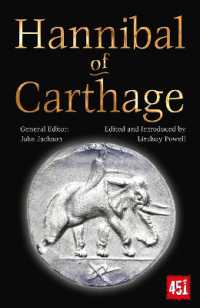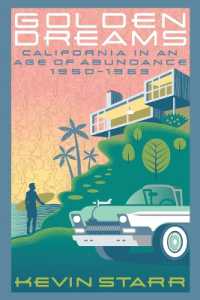Full Description
For students with moderate to severe disabilities, instruction in physical education can be a challenge. Many teachers struggle with understanding these students' complex needs, selecting appropriate content, and finding ways to motivate these students. While many educators consider the social aspects of inclusion a priority, the authors in this text stress active engagement with the curriculum and the use of grade-level outcomes to adapt learning for students with a range of abilities. One thing is certain: The keys to making physical education a positive learning experience are the physical education teachers and adapted physical education teachers who work with these students. This text is for you!
Edited by experienced educators with expertise in general and adapted physical education programming, Physical Education for Children With Moderate to Severe Disabilities will serve as a valuable resource:
• Offers comprehensive strategies for instruction, assessment, communication, collaborative practices, peer supports, and effective use of paraeducators
• Describes unique equipment modifications and alternative programming suggestions
• Includes sample lesson plans and assessments that you can use as is or use as models to create your own
• Is applicable for children with moderate to severe disabilities in general physical education classes and self-contained PE environments
Physical Education for Children With Moderate to Severe Disabilities was written by a team of higher education professionals, practicing physical educators, and adapted PE teachers. These contributors combine to bring a rich diversity and a variety of perspectives that ensure the content is relevant to all teachers. Through this comprehensive text, you will be able to make sure you are complying with the legal requirements associated with the Individuals with Disabilities Education Improvement Act and the Every Student Succeeds Act, which require that children with disabilities be given the same opportunities for meaningful physical education as other children.
The text is organized into three parts. Part I provides foundational information on key adapted physical education issues, including Universal Design for Learning, collaborative processes, assessment strategies, communication practices, and how to use peer tutors and paraeducators in physical education.
Part II helps you acquire the skills you need to teach students with disabilities. The five chapters in this section will help you understand sensory integration theory, develop foundational skills, put your plan into action, and understand your role and the paraeducator's role in disability sport. You'll also learn how to establish and assess disability sport, how to program for and assess students in aquatics, and how to help students transition to recreational opportunities in the community.
In Part III, you receive a blueprint for implementing successful activities at all levels. Included are team sports and target games (track and field, basketball, golf, bowling, and more) as well as lifetime activities (bicycling, tennis, personal fitness planning, and more).
The result is a resource that provides all the information and guidance you need to deliver appropriate physical education to children with moderate to severe disabilities. The book will inspire you to consider the unlimited avenues for participation in sport and physical activity for all your students—even those with the most severe disabilities.
Contents
Foreword
Preface
Acknowledgments
Part I: Best Practices for Engaging All Students
Chapter 1: Understanding Severe Disabilities and Universal Design for Learning
Severe Disabilities
Individuals with Disabilities Education Act
Universal Design for Learning
Summary
Chapter 2: Collaborative Processes in Physical Education
The Practice of Collaboration
Becoming Part of the Education Team
Developing Adapted Physical Education Goals Through Shared Goals
Steps in the Collaborative Process
Summary
Chapter 3: Assessment Strategies
Functional Assessment of Students With Severe Disabilities
Rubrics
Task Analysis Assessment
Ecological Task Analysis
Basic Skills Assessment
Summary
Chapter 4: Communication Practices That Enhance Participation
Considerations for Communication Practices in Physical Education
Types of Communication Practices
Summary
Chapter 5: Peer Tutoring
Selecting Peer Tutors
Training Peer Tutors
Evaluating the Tutoring Experience
Summary
Chapter 6: Paraeducators in Physical Education
Understanding the Paraeducator's Role
Training for Paraeducators
Ideas for Acknowledging Paraeducators' Contributions
Summary
Chapter 7: Creating Accessible Equipment
Adapting Equipment With SENSE
Six Ss for Adapting Equipment
Summary
Part II: Participation for All in Sport Activities
Chapter 8: Foundational Skills and Sensory Integration
Understanding Sensory Integration Theory
Developing Foundational Skills
Putting Your Plan Into Action
Summary
Chapter 9: Disability Sport in Physical Education
Sport Opportunities for Children With Severe Disabilities
Role of the Teacher and Coach in Disability Sport
Summary
Chapter 10: Modified Programming in Physical Education
Establishing Disability Sports Within the Physical Education Curriculum
Assessment in Disability Sport
Summary
Chapter 11: Transitioning to Recreational Opportunities Beyond School
Transition Services and Individuals' Rights
Initiating the Transition Plan
Transition Processes in Physical Education
Training Personnel for Community-Based Programs
Summary
Chapter 12: Aquatics for Children With Disabilities
Benefits of Aquatics
Medical Issues, Precautions, and Safety Issues
Assessment in Aquatics
Planning Goals and Objectives
Teaching and Safety Strategies
Transitioning to Aquatics in the Community
Summary
Part III: Sample Lessons Using Universal Design for Learning
Chapter 13: Team Sports and Target Games
Soccer: Passing
Basketball: Spot Remover
Hockey: Rip Off
Track and Field: Hurdling
Golf: Putting
Golf: Stations
Golf: Alien Invasion
Throlf (Throwing Golf)
Bowling for Junk
Bowling: Battleships
Bowling for Bucks
Archery: Safety First
Archery: Add It Up
Chapter 14: Lifetime and Health-Related Activities
Hand Function Challenges
Hand Functions for Sports
Scooter Train
Climbing Wall: Periwinkle Rescue
Horseshoes
Bicycling: Rules of the Road
Tennis: Forehand Stroke
Tabletop Shuffleboard
Personal Fitness Plan
Appendix: Resources







